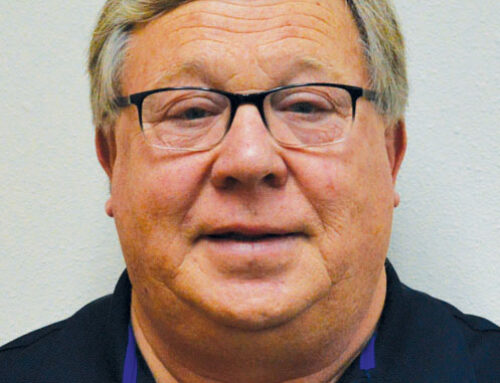Adria Whiting of Mayo Clinic Health System and Bryon Nelsen of Lakeview Methodist Health Care System collaborated on a protocol that achieved a 71 percent decrease in hospital readmission rates for congestive heart failure patients.
FAIRMONT — After six months of planning followed by six months of practice, a new protocol has resulted in an astounding 71 percent drop in hospital readmission rates for congestive heart failure (CHF) patients at Fairmont nursing home. The program was developed by Adria Whiting, a nurse practitioner, who is the lead of Mayo Clinic Health Care System’s nursing home program. She collaborated with Bryon Nelsen, director of nursing at Lakeview Methodist Health Care Center in Fairmont, to implement the new program with Mayo patients who are residents at Lakeview.
Whiting covers five nursing homes in the area — Lakeview and Lutz Wing in Fairmont, and nursing homes in Truman, Trimont and Armstrong — spending two or three days a week checking on Mayo patients in each site. Many of the residents she sees have CHF, which can be caused by high blood pressure, a common condition with the aging population. Something as commonplace as a ham dinner, which contains a high level of salt, can cause fluid build-up and exacerbate CHF.
“Your heart is a pump,” Whiting explained. “With congestive heart failure, that pump is not working as effectively so the blood is not getting where it needs to go. Fluid backs up into lungs. You have difficulty breathing, swelling in the legs. Your heart is not pumping oxygen where it needs to go so you’re more tired. Heart failure is a progressive illness that there’s really no cure for.”
With the influx of in-home care, more people are able to stay in their homes for a longer period of time. As a result, nursing homes are seeing more and more new residents with complex health issues requiring a higher level of care. Due to Medicare and Medicaid requirements, patients are being released from the hospital to nursing homes for a short-term stay for rehabilitation or recovery as a bridge gap before returning to their homes, another practice that requires a higher level of care.
“Nationally, 20 percent of people on Medicare will be readmitted to the hospital within 30 days,” Whiting said, adding that hospitals and nursing homes are penalized for re-admissions within within that time period. “I was noticing higher readmission rates (for CHF patients) and trying to think of what we could do to stem that flow back to the hospital. I did some research and came up with a protocol for CHF patients in nursing homes.”
Her program design focuses on three key pieces: identifying those residents who needed to be monitored more closely and what interventions to have in place to avoid readmission; creating a flow plan that was easy to follow; and creating an education piece so that the nurses knew the process.
Whiting contacted Nelsen at Lakeview, which has the largest number of residents and the highest number of Mayo patients out of the five nursing homes she visits. She estimates that at any given time, as many as 20 of Lakeview’s 70 residents could have CHF.
“Adria and I sat down and determined what we wanted to see out of the program, what we needed to do to keep these people in the nursing home rather than having to go to the emergency room,” Nelsen said. “We put some guidelines down of what we do at Lakeview and how Adria follows up so we have more cohesive care for our CHF patients. CHF is always a hot topic in the medical industry. It’s just a big problem.”
“Most residents also have other conditions such as Alzheimer’s or dementia or Parkinson’s so when you take them out of their usual environment if they have to go to the hospital, they’re going to decline. Then when they come back to the nursing home, there’s another adjustment,” Whiting said.
“We’re the only nursing home out of her group to pilot the program,” Nelsen said. “At first, it was a little overwhelming, but we’ve settled in. We educate families. We continue with staff education, with nursing, with dietary, with everybody. We get everybody involved. We expect it of our staff, and the staff expects it of each other.
“My hope is to take the results and roll it out to the other physicians that serve us,” Nelsen said, noting that Dr. Jeffrey Greene, Mayo physician who serves as medical director at Lakeview, was “an easy sell” and “very supportive” of the project. “We track it with Mayo patients only because that’s who the project was with, but we treat all our residents the same.”
“It was a glaring opportunity for improvement. Staff education is the key,” Whiting said.
After six months of planning and education behind the scenes, Lakeview debuted the program at the beginning of the year and monitored the steady decline in readmissions of Mayo patients with CHF
“I was surprised with the results. I was over the moon,” Whiting said. “It’s a lot of work to roll out something, and you’ve got to have leadership that’s engaged. It’s a great partnership. It’s a team effort. It takes teamwork to have something be successful like this.”
“We take pride in the results. To say we were the pilot program with something successful with Mayo is nice to be able to do,” Nelsen said. “Plus, I think the families appreciate the fact that they’re not making as many emergency room trips or as many hospital trips.”
With the success of the new CHF protocols, Lakeview and Mayo are considering additional collaborations, such as video staff visits or ways to reduce infections. Regionally, Mayo is hoping to get approval to roll out the CHF protocols at other nursing homes in its southwest region.
“There’s always opportunities out there,” Whiting said. “We’re looking at the comfort of the residents. We’re looking at their quality of life in the setting they’re in.”
About the Author
Judy Bryan
Staff Writer
jbryan@fairmontsentinel.com






